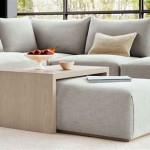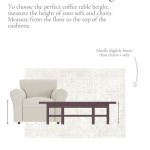How to Decorate a Side Table: A Comprehensive Guide
Side tables, often overlooked in the grand scheme of room design, serve as functional and decorative anchors within a living space. They provide a convenient surface for lamps, beverages, books, and various personal items, all while contributing to the overall aesthetic appeal of the room. Effective side table decoration involves a thoughtful balance of functionality, visual harmony, and personal style. This article outlines key strategies for transforming a simple side table into a stylish and practical focal point.
The process of decorating a side table extends beyond simply placing objects on its surface. It requires careful consideration of the table's size, shape, and placement within the room, as well as the surrounding décor. A well-decorated side table should complement the existing furniture and color scheme, while also offering a practical solution for everyday needs. Moreover, the chosen items should reflect the homeowner's personality and contribute to the overall ambiance of the space. Ultimately, a successful side table design is one that is both visually appealing and highly functional.
Understanding the Fundamentals of Side Table Styling
Before embarking on the actual decorating process, it is crucial to grasp the fundamental principles that underpin effective side table styling. These principles encompass proportion, balance, color harmony, and functionality. Applying these concepts will help create a visually pleasing and practical arrangement.
Proportion: The size and scale of the items placed on the side table should be proportionate to the table itself and the surrounding furniture. Overly large or small objects can disrupt the visual balance and make the arrangement appear awkward. A general guideline is to choose items that are approximately two-thirds the height and width of the table. Larger tables can accommodate larger and more numerous items, while smaller tables require a more minimalist approach. It's important to consider the height of adjacent furniture, such as sofas or chairs, to ensure that the side table doesn't appear dwarfed or overly imposing. A tall lamp on a small table, for example, can easily overwhelm the space and appear out of place.
Balance: Creating a sense of visual balance is essential for a harmonious side table arrangement. This can be achieved through symmetrical or asymmetrical arrangements. Symmetrical balance involves mirroring items on either side of a central point, creating a formal and traditional look. Asymmetrical balance, on the other hand, involves using different sized and shaped objects to create a visually appealing arrangement that is not perfectly symmetrical. This approach tends to be more modern and dynamic. When using asymmetrical balance, it is important to ensure that the overall arrangement feels balanced and stable, even though the items are not identical. For instance, a tall lamp on one side can be counterbalanced by a stack of books and a decorative object on the other.
Color Harmony: The colors used in the side table arrangement should complement the overall color scheme of the room. This does not necessarily mean that all of the items must be the same color, but rather that they should work together harmoniously. Choose colors that are either analogous (adjacent on the color wheel) or complementary (opposite on the color wheel). For example, if the room has a blue and green color scheme, consider using accessories in shades of blue, green, or even a complementary color like coral. Neutrals, such as white, beige, and gray, can also be used to create a sense of balance and sophistication. Pops of color can be introduced through accent pieces, such as flowers or vases, to add visual interest and personality to the arrangement.
Functionality: While aesthetics are important, a side table should also be functional. Consider the practical needs of the space and choose items that serve a purpose. A lamp provides lighting, a coaster protects the table surface, and a decorative box can conceal clutter. Think about how the side table will be used and choose items that enhance its functionality. For example, if the side table is next to a reading chair, a lamp and a place to rest a drink are essential. If the side table is primarily for decorative purposes, focus on showcasing aesthetically pleasing objects that reflect personal style. Functionality shouldn't be an afterthought; it should be integrated into the design process from the beginning.
Selecting the Right Items for Your Side Table
Choosing the right items to place on your side table is crucial for creating a visually appealing and functional arrangement. The selection should be carefully curated to reflect personal style, complement the surrounding décor, and serve practical purposes. Here are some essential items to consider:
Lighting: A lamp is often the centerpiece of a side table arrangement, providing both ambient and task lighting. Choose a lamp that is appropriately sized for the table and the surrounding space. The height of the lamp should be such that the light falls at a comfortable level for reading or other activities. Consider the style of the lamp and choose one that complements the overall aesthetic of the room. A traditional lamp with a fabric shade might be suitable for a classic interior, while a sleek modern lamp with a metal base might be a better choice for a contemporary space. The wattage of the bulb should also be considered to ensure adequate lighting without being overly harsh.
Books: Books add character and personality to a side table arrangement. Choose books that reflect personal interests and create a visually appealing stack. Hardcover books are generally more visually appealing than paperbacks, and their spines can add color and texture to the arrangement. Arrange the books in a neat stack, either horizontally or vertically. A small decorative object can be placed on top of the stack to add visual interest. Coffee table books with beautiful photography or artwork can also be used to add a touch of sophistication to the side table. The placement of books can also serve a functional purpose, such as raising a smaller object to a more visually prominent height.
Greenery or Flowers: Adding a touch of nature to a side table arrangement can instantly brighten up the space and create a sense of freshness. A small potted plant, a vase of fresh flowers, or even a few sprigs of greenery can make a significant difference. Choose plants or flowers that complement the color scheme of the room and are easy to care for. Succulents are a popular choice for their low maintenance and attractive appearance. Artificial plants can also be used, but be sure to choose high-quality options that look realistic. The texture and color of the greenery can add visual interest and break up the monotony of the arrangement.
Decorative Objects: Decorative objects add personality and visual interest to a side table arrangement. Choose items that reflect personal style and complement the surrounding décor. These can include sculptures, vases, candles, trays, or small boxes. The objects should be carefully chosen to create a cohesive and visually appealing arrangement. Consider the size, shape, and color of the objects and how they work together. A small tray can be used to contain smaller items, such as keys or jewelry, and keep the surface organized. A decorative box can be used to conceal clutter and add a touch of elegance to the arrangement. The key is to choose objects that are meaningful and visually appealing, rather than simply filling the space with random items.
Arrangement Strategies for a Polished Look
The way in which items are arranged on a side table is just as important as the items themselves. A well-arranged side table should be visually appealing, functional, and balanced. Here are some strategies for creating a polished look:
The Rule of Three: The rule of three is a design principle that suggests that items arranged in odd numbers are more visually appealing than those arranged in even numbers. This is because odd numbers create a sense of asymmetry and visual interest. When decorating a side table, try grouping items in sets of three or five. For example, a lamp, a stack of books, and a decorative object can create a visually balanced and appealing arrangement. The items can be of varying heights and textures to add visual interest. The rule of three is a guideline, not a strict rule, and can be adapted to suit individual preferences and the specific items being used.
Creating Height and Depth: Adding height and depth to a side table arrangement is essential for creating visual interest and preventing the arrangement from feeling flat. This can be achieved by using items of varying heights and layering them strategically. A tall lamp, a stack of books, or a vase of flowers can be used to add height to the arrangement. Smaller objects can be placed in front of or behind these taller items to create depth. The layering of objects can also create a sense of visual interest and prevent the arrangement from feeling static. For example, a decorative box can be placed behind a stack of books, with a small object placed on top of the box to create a layered effect.
Negative Space: Negative space, or empty space, is an important element of design that is often overlooked. Leaving some empty space on a side table can prevent the arrangement from feeling cluttered and overwhelming. Negative space allows the eye to rest and appreciate the individual items in the arrangement. It also creates a sense of balance and harmony. Avoid filling every available space on the table with objects. Instead, leave some areas open to create a sense of calm and sophistication. The amount of negative space will depend on the size of the table and the number of items being used.
Experimentation and Personalization: Ultimately, the best way to decorate a side table is to experiment and personalize the arrangement to reflect individual style and preferences. Don't be afraid to try different combinations of items and arrangements until you find something that you love. Consider the overall aesthetic of the room and choose items that complement the existing décor. Personalize the arrangement by incorporating items that are meaningful and that reflect personal interests. The side table should be a reflection of personality and style, rather than simply a generic arrangement.
By carefully considering proportion, balance, color harmony, functionality, item selection, and arrangement strategies, transforming a simple side table into a stylish and functional focal point becomes achievable. The outcome enhances the overall aesthetic of the room and provides a convenient surface for everyday necessities.

How To Style An End Table Like A Pro Stonegable

5 Must Haves For Your Side Table How To Decorate

Home Decor 101 How To Decorate End Tables The Turquoise

Tips For Decorating End Tables The Lazy Girl S Timesaving

Simplified Decorating End Table Decor Ideas Bless Er House

How To Decorate A Nightstand Stonegable

Home Decor 101 How To Decorate End Tables

Side Table Decor Ideas 33 Best Stylish Functional End Tables For Your Home Parachute

How To Style An End Table Like A Pro Stonegable

2024 Decorate With Me Side Tables Styling Easy Youtube








